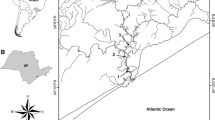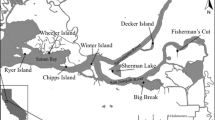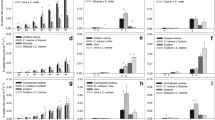Abstract
Salinity can compromise the growth of aquatic macrophytes, influencing their nutrient content and interspecific interactions. In estuaries, the sediment characteristics vary in salinity as well as nutrient availability, granulometry and microbiota. The use of artificial substrates in manipulative experiments allows the evaluation of the isolated effect of salinity on plants. We evaluated the effects of salinity on growth, interspecific interaction and total nitrogen (TN) content of the estuarine macrophytes Spartina alterniflora and Crinum americanum cultivated on expanded vermiculite. We conducted a two-factor experiment (3 cultures × 3 salinities × 5 replicates = 45 experimental units) lasting 185 days in a greenhouse. We cultivated monocultures (8:0 and 0:8) and mixed cultures (4:4) at 0, 20 and 30 ppt salinity levels with the same concentration of nutrient solution. We found that salinity did not influence the growth of S. alterniflora and C. americanum in monoculture. In mixed culture, there was an asymmetric competition, as S. alterniflora limited the growth of the aboveground fraction of C. americanum at higher salinity; however, C. americanum did not limit the growth of S. alterniflora at any treatment. Salinity did not influence the TN content in S. alterniflora. However, C. americanum had greater TN content in the aboveground fraction at higher salinity, possibly as a strategy of salt tolerance. The TN content in the aboveground fraction of C. americanum was lower in the mixed cultures than in the monocultures, indicating an effect of the interspecific interaction.



Similar content being viewed by others
References
Allen SE, Grimshaw HM, Parkinson JA, Quarmby C (1974) Chemical analysis of ecological materials. Blackwell, Oxford
Angelstein S, Wolfram C, Rahn K, Kiwel U, Frimel S, Merbach I, Schubert H (2009) The influence of different sediment nutrient contents on growth and competition of Elodea nuttallii and Myriophyllum spicatum in nutrient-poor waters. Fundam Appl Limnol 175:49–57. https://doi.org/10.1127/1863-9135/2009/0175-0049
Barko JW, Gunnison D, Carpenter SR (1991) Sediment interactions with submersed macrophyte growth and community dynamics. Aquat Bot 41:41–65. https://doi.org/10.1016/0304-3770(91)90038-7
Bockelmann AC, Neuhaus R (1999) Competitive exclusion of Elymus athericus from a high-stress habitat in a European salt marsh. J Ecol 76:503–513. https://doi.org/10.1046/j.1365-2745.1999.00368.x
Brown JJ (1998) Halophytes for the treatment of saline aquaculture effluent. Dissertation, The University of Arizona
Brown CE, Pezeshki SR, DeLaune RD (2006) The effects of salinity and soil drying on nutrient uptake and growth of Spartina alterniflora in a simulated tidal system. Environ Exp Bot 58:140–148. https://doi.org/10.1016/j.envexpbot.2005.07.006
Cavalieri AJ, Huang AH (1981) Accumulation of proline and glycinebetaine in Spartina alterniflora Loisel. in response to NaCl and nitrogen in the marsh. Oecologia 49:224–228. https://doi.org/10.1007/BF00349192
Céccoli G, Ramos J, Pilatti V, Dellaferrera I, Tivano JC, Taleisnik E, Vegetti AC (2015) Salt glands in the Poaceae family and their relationship to salinity tolerance. Bot Rev 81:162–178. https://doi.org/10.1007/s12229-015-9153-7
Chambers RM, Mozdzer TJ, Ambrose JC (1998) Effects of salinity and sulfide on the distribution of Phragmites australis and Spartina alterniflora in a tidal saltmarsh. Aquat Bot 62:161–169. https://doi.org/10.1016/S0304-3770(98)00095-3
Courtney AJ, Xu J, Xu Y (2016) Responses of growth, antioxidants and gene expression in smooth cordgrass (Spartina alterniflora) to various levels of salinity. Plant Physiol Biochem 99:162–170. https://doi.org/10.1016/j.plaphy.2015.12.016
Crain CM (2007) Shifting nutrient limitation and eutrophication effects in marsh vegetation across estuarine salinity gradients. Estuar Coast 30:1–9. https://doi.org/10.1007/BF02782964
Crain CM, Silliman BR, Bertness SL, Bertness MD (2004) Physical and biotic drivers of plant distribution across estuarine salinity gradients. Ecology 85:2539–2549. https://doi.org/10.1890/03-0745
Dutilh JHA, Oliveira RS (2015) Amaryllidaceae. In: Lista de Espécies da Flora do Brasil. Jardim Botânico do Rio de Janeiro. http://floradobrasil.jbrj.gov.br/. Accessed 10 Dec 2019
Engels JG, Jensen K (2010) Role of biotic interactions and physical factors in determining the distribution of marsh species along an estuarine salinity gradient. Oikos 119:679–685. https://doi.org/10.1111/j.1600-0706.2009.17940.x
Esteves BS, Suzuki MS (2008) Efeito da salinidade sobre as plantas. Oecol Bras 12:662–679. https://doi.org/10.4257/oeco.2008.1204.06
Eyre D, Balls P (1999) A comparative study of nutrient behavior along the gradient of tropical and temperate estuaries. Estuaries 22:313–326. https://doi.org/10.2307/1352987
Flowers TJ, Munns R, Colmer TD (2015) Sodium chloride toxicity and the cellular basis of salt tolerance in halophytes. Ann Bot 115:419–431. https://doi.org/10.1093/aob/mcu217
Gibson DJ, Connolly J, Hartnett D, Weidenhamer JD (1999) Designs for greenhouse studies of interactions between plants. J Ecol 87:1–16. https://doi.org/10.1046/j.1365-2745.1999.00321.x
Gomes MAC, Pestana IA, Santa-Catarina C, Hauser-Davis RA, Suzuki MS (2017) Salinity effects on photosynthetic pigments, proline, biomass and nitric oxide in Salvinia auriculata Aubl. Acta Limnol Bras 29:1–13. https://doi.org/10.1590/s2179-975x4716
GraphPad Software (2007) Prism (data analysis software system), version 5.0
Gribben PE, Nielsen S, Seymour JR, Bradley DJ, West MN, Thomas T (2017) Microbial communities in marine sediments modify success of an invasive macrophyte. Sci Rep 7:1–8. https://doi.org/10.1038/s41598-017-10231-2
Guo H, Pennings SC (2012) Mechanisms mediating plant distributions across estuarine landscapes in a low-latitude tidal estuary. Ecology 93:90–100. https://doi.org/10.1890/11-0487.1
Hoagland DR, Arnon DI (1950) The water-culture method for growing plants without soil. California Agricultural Experiment Station, Berkeley
Houle G, Morel L, Reybolds CE, Siegel J (2001) The effect of salinity on different development stages of an endemic annual plant, Aster laurentianus (Asteraceae). Am J Bot 88:62–67. https://doi.org/10.2307/2657127
Howard RJ, Biagas J, Allain L (2006) Growth of common brackish marsh macrophytes under altered hydrologic and salinity regimes. Wetlands 36:11–20. https://doi.org/10.1007/s13157-015-0711-x
Hu Y, Schmidhalter U (2005) Drought and salinity: a comparison of their effects on mineral nutrition of plants. J Plant Nutr Soil Sci 168:541–549. https://doi.org/10.1002/jpln.200420516
Huckle JM, Potter JA, Marrs RH (2000) Influence of environmental factors on the growth and interactions between salt marsh plants: effects of salinity, sediment and waterlogging. J Ecol 88:492–505. https://doi.org/10.1046/j.1365-2745.2000.00464.x
Levine JM, Brewer JS, Bertness MD (1998) Nutrients, competition and plant zonation in a New England salt marsh. J Ecol 85:285–292. https://doi.org/10.1046/j.1365-2745.1998.00253.x
Li R, Shi F, Fukuda K (2010) Interactive effects of various salt and alkali stresses on growth, organic solutes, and cation accumulation in a halophyte Spartina alterniflora (Poaceae). Environ Exp Bot 68:66–74. https://doi.org/10.1016/j.envexpbot.2009.10.004
Ma J, Chai M, Shi F (2011) Effects of long-term salinity on the growth of the halophyte Spartina alterniflora Loisel. Afr J Biotechnol 10:17962–17968. https://doi.org/10.5897/AJB11.2300
Mansour MMF (2000) Nitrogen containing compounds and adaptation of plants to salinity stress. Biol Plant 43:491–500. https://doi.org/10.1023/A:1002873531707
Martins CC, Bovi MLA, Spiering SH (2009) Umedecimento do substrato na emergência e vigor de plântulas de pupunheira. Rev Bras de Frutic 31:224–230. https://doi.org/10.1590/S0100-29452009000100031
Medeiros DL, White DS, Howes BL (2013) Replacement of Phragmites australis by Spartina alterniflora: the role of competition and salinity. Wetlands 33:421–430. https://doi.org/10.1007/s13157-013-0400-6
Meerow AW, Lehmiller DJ, Clayton JR (2003) Phylogeny and biogeography of Crinum L. (Amaryllidaceae) inferred from nuclear and limited plastid non-coding DNA sequences. Bot J Linn Soc 141:349–363. https://doi.org/10.1046/j.1095-8339.2003.00142.x
Mendelssohn IA, McKee KL, Kong T (2001) A comparison of physiological indicators of sublethal cadmium stress in wetland plants. Environ Exp Bot 46:263–275. https://doi.org/10.1016/S0098-8472(01)00106-X
Middleton BA (2016) Effects of salinity and flooding on post-hurricane regeneration potential in coastal wetland vegetation. Am J Bot 103:1420–1435. https://doi.org/10.3732/ajb.1600062
Nunes LSC, Camargo AFM (2017) A simple non-destructive method for estimating aboveground biomass of emergent aquatic macrophytes. Acta Limnol Bras 29:1–6. https://doi.org/10.1590/s2179-975x6416
Nunes LSC, Camargo AFM (2018) Do interspecific competition and salinity explain plant zonation in a tropical estuary? Hydrobiologia 812:67–77. https://doi.org/10.1007/s10750-016-2821-8
Nunes LSC, Camargo AFM (2020) The interspecific competition of tropical estuarine macrophytes is not density-dependent. Aquat Bot. https://doi.org/10.1016/j.aquabot.2020.103233
Partridge TR, Wilson JB (1987) Salt tolerance of salt marsh plants of Otago, New Zealand. J Bot 25:559–566. https://doi.org/10.1080/0028825X.1987.10410086
Pennings SC, Callaway RM (1992) Salt marsh plant zonation: the relative importance of competition and physical factors. Ecology 73:681–690. https://doi.org/10.2307/1940774
Pezeshki S, DeLaune R (1995) Variations in response of two US Gulf Coast populations of Spartina alterniflora to hypersalinity. J Coast Res 11:89–95
Ribeiro JP, Matsumoto RS, Takao LK, Peret AC, Lima MIS (2011) Spatial distribution of Crinum americanum in the tropical blind estuary: hydrologic, edaphic and biotic drivers. Environ Exp Bot 71:287–291. https://doi.org/10.1016/j.envexpbot.2010.12.011
Rodriguez RJ, Henson J, Van Volkenburgh E, Hoy M, Wright L, Beckwith F, Kim Y, Redman SR (2008) Stress tolerance in plants via habitat-adapted symbiosis. ISME J 2:404–416. https://doi.org/10.1038/ismej.2007
Sackville-Hamilton NR (1994) Replacement and additive designs for plant competition studies? J Appl Ecol 31:599–603. https://doi.org/10.2307/2404150
Schaeffer-Novelli Y, Cintrón-Molero G, Adaime RR, Camargo TM (1990) Variability of mangrove ecosystems along the Brazilian coast. Estuaries 13:204–218. https://doi.org/10.2307/1351590
StatSoft (2005) Statistica (Data Analysis Software System), Version 7.1. http://www.statsoft.com
Tang L, Gao Y, Li B, Wang Q, Wang CH, Zhao B (2014) Spartina alterniflora with high tolerance to salt stress changes vegetation pattern by outcompeting native species. Ecosphere 5:1–18. https://doi.org/10.1890/ES14-00166.1
Tootoonchi M, Gettys LA (2019) Testing salt stress on aquatic plants: effect of salt source and substrate. Aquat Ecol 53:325–334. https://doi.org/10.1007/s10452-019-09692-6
Tram NTN, Titorenkova TV, Bankova VS, Handjieva NV, Popov SS (2002) Crinum L. (Amaryllidaceae). Fitoterapia 73:183–208. https://doi.org/10.1016/S0367-326X(02)00068-0
Twilley RR, Barko JW (1990) The growth of submersed macrophytes under experimental salinity and light conditions. Estuaries 13:311–321. https://doi.org/10.2307/1351922
Ugarte JFO, Sampaio JA, França SCA (2008) Vermiculita. In: Luz AB, Lins FAF (eds) Rochas & minerais industriais: usos e especificações, 2nd edn. CETEM/MCT, Rio de Janeiro, pp 865–888
Xiao Y, Tang J, Qing H, Zhou C, Na S (2011) Effects of salinity and clonal integration on growth and sexual reproduction of the invasive grass Spartina alterniflora. Flora 206:736–741. https://doi.org/10.1016/j.flora.2010.12.003
Yuan Z, Druzhinina IS, Labbé J, Redman R, Qin Y, Rodriguez R, Zhang C, Tuskan GA, Lin F (2016) Specialized microbiome of a halophyte and its role in helping non-host plants to withstand salinity. Sci Rep 6:1–13. https://doi.org/10.1038/srep32467
Zhang HX, Zhang GM, Lu XT, Zhou DW, Han XG (2015) Salt tolerance during seed germination and early seedling stages of 12 halophytes. Plant Soil 388:229–241. https://doi.org/10.1007/s11104-014-2322-3
Acknowledgements
LSCN thanks the São Paulo Research Foundation for her Ph.D. fellowship (FAPESP Grant #2016/01416-4). AFMC thanks the Brazilian Council of Research (CNPq) for his Research Productivity Grant. The authors thank the Higher Education Improvement Coordination (CAPES) for supporting the Graduate Program in Biological Sciences (Plant Biology). We are also grateful to Carlos Fernando Sanches and Rachel Santini Paulino for helping the experiment development.
Author information
Authors and Affiliations
Contributions
LSCN and AFMC conducted the research and wrote the manuscript.
Corresponding author
Ethics declarations
Conflict of interest
The authors declare that they have no conflict of interest.
Additional information
Handling Editor: Télesphore Sime-Ngando.
Publisher's Note
Springer Nature remains neutral with regard to jurisdictional claims in published maps and institutional affiliations.
Electronic supplementary material
Below is the link to the electronic supplementary material.
Rights and permissions
About this article
Cite this article
Nunes, L.S.C., Camargo, A.F.M. Effects of salinity on growth, competitive interaction and total nitrogen content of two estuarine macrophyte species cultivated on artificial substrate. Aquat Ecol 54, 973–983 (2020). https://doi.org/10.1007/s10452-020-09787-5
Received:
Accepted:
Published:
Issue Date:
DOI: https://doi.org/10.1007/s10452-020-09787-5




